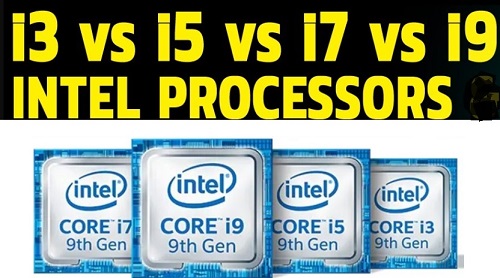Compare Core i9, Core i7 Core i5 Core i3 Processors – Intel’s Core i3, Core i5, and Core i7 processors are part of the Intel Core processor family, and they vary in terms of performance, features, and target applications.

Compare Core i9 i7 i5 and i3 Processors
In Short: Differences between i3, i5, i7 and i9 Processors. Intel Core i3 is an entry-level processor design for low-end applications. Intel Core i5 is a mid-range processor developed for everyday use computer systems. Intel Core i7 is a high-end processor designed for applications that need high processing power. Core i9 processors are Intel’s highest-performing consumer processors, designed for extreme performance and handling the most demanding tasks, including gaming, 3D rendering, and heavy content creation.
Here’s a general comparison of the Core i Processors:
- Core i3:
- Performance: Core i3 processors are typically the entry-level processors in the Intel Core series. They offer decent performance for basic computing tasks, such as web browsing, office work, and multimedia consumption.
- Cores/Threads: Core i3 processors usually have 2 to 4 cores and support hyperthreading, which allows them to handle multiple threads simultaneously.
- Integrated Graphics: Most Core i3 processors come with integrated graphics, which is sufficient for everyday graphics needs but not suitable for demanding gaming or professional graphics work.
- Target Applications: Core i3 processors are best for budget-conscious users who need a computer for everyday tasks and don’t require high-end performance.
- Core i5:
- Performance: Core i5 processors offer a balanced mix of performance and power efficiency. They are suitable for a broader range of tasks, including light gaming, content creation, and multitasking.
- Cores/Threads: Core i5 processors typically have 4 to 6 cores and support hyperthreading.
- Integrated Graphics: Some Core i5 processors come with integrated graphics, but they may also be paired with dedicated graphics cards for better gaming or graphics performance.
- Target Applications: Core i5 processors are a good choice for mainstream users who want a solid all-around computing experience, including some gaming and content creation.
- Core i7:
- Performance: Core i7 processors are high-performance processors designed for more demanding tasks. They excel in tasks like video editing, 3D rendering, and gaming.
- Cores/Threads: Core i7 processors often have 4 to 8 cores and support hyperthreading, which provides excellent multitasking capabilities.
- Integrated Graphics: Some Core i7 processors come with integrated graphics, but many are designed for use in systems with dedicated graphics cards.
- Target Applications: Core i7 processors are ideal for power users, gamers, and professionals who need top-tier performance for resource-intensive applications.
- Core i9:
- Performance: Core i9 processors are Intel’s highest-performing consumer processors, designed for extreme performance and handling the most demanding tasks, including gaming, 3D rendering, and heavy content creation.
- Cores/Threads: Core i9 processors typically have 8 to 18 cores and support hyperthreading, which provides exceptional multitasking and parallel processing capabilities.
- Integrated Graphics: Most Core i9 processors do not come with integrated graphics and are intended for use in systems with dedicated graphics cards for optimal performance.
- Target Applications: Core i9 processors are the top choice for enthusiasts, gamers, and professionals who require the ultimate in CPU performance for resource-intensive applications.
It’s important to note that within each category (i3, i5, i7,i9), there are various generations and specific models with varying clock speeds and features. Therefore, it’s essential to consider the specific processor model and its capabilities when making a purchasing decision. Additionally, Intel has released newer processor families, such as Core i9 and Xeon, which offer even higher levels of performance for specialized applications.
Here are the generations of Intel Core i processors. Intel releases new generations of processors regularly to improve performance, power efficiency, and introduce new features:
- First Generation (Nehalem): These processors were part of the initial Intel Core processor family, launched in 2008. They featured the Nehalem microarchitecture and introduced features like Turbo Boost and Hyper-Threading.
- Second Generation (Sandy Bridge): Sandy Bridge processors were introduced in 2011. They brought significant improvements in performance and introduced new integrated graphics options.
- Third Generation (Ivy Bridge): Ivy Bridge processors, released in 2012, focused on improved power efficiency and integrated graphics performance.
- Fourth Generation (Haswell): Haswell-based processors arrived in 2013, offering improved CPU and GPU performance and new features like AVX2 instruction support.
- Fifth Generation (Broadwell): Broadwell processors, released in 2014, continued to improve power efficiency and introduced smaller process technology.
- Sixth Generation (Skylake): Skylake processors, launched in 2015, focused on delivering better CPU and GPU performance, along with support for DDR4 memory.
- Seventh Generation (Kaby Lake): Kaby Lake processors came out in 2016, offering refinements in integrated graphics and improved clock speeds.
- Eighth Generation (Coffee Lake): The Coffee Lake family, released in 2017, introduced processors with higher core counts and improved performance.
- Ninth Generation (Coffee Lake Refresh): This generation, also part of the Coffee Lake family, continued to offer strong performance for mainstream users in 2018.
- Tenth Generation (Comet Lake): Comet Lake processors were introduced in 2020, featuring improvements in clock speeds and integrated graphics capabilities.
- Eleventh Generation (Tiger Lake): Tiger Lake processors, released in 2020, brought significant advancements in integrated graphics performance, power efficiency, and AI capabilities.
- Twelfth Generation (Alder Lake): Alder Lake processors, introduced in late 2021, marked a significant shift with a hybrid architecture featuring high-performance and high-efficiency cores for improved power efficiency and performance.
![]()